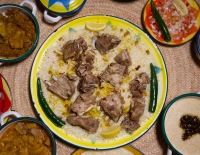
Suhur meal in the Kingdom of Saudi Arabia is the last meal that a fasting person eats before abstaining from food during the month of Ramadan and the days of fasting. Suhur begins after midnight and usually occurs early enough before al-Fajr (dawn) call to prayer. Family members gather to feast on the Suhur meal. In the evening, it is followed by the Iftar meal at the Maghrib call to prayer. As opposed to the traditional three meals distributed throughout the day, meals on fasting days begin ...

The Saudi Ardah Flag is a large banner that stands in the midst of rows of Ardah performers during the Saudi Ardah performance in official celebrations in the Kingdom of Saudi Arabia. It is called 'al-Bairaq' and is a fundamental component of the Ardah, with a width equal to two-thirds of its length. It features the spearhead, finial, and chains. The Saudi Ardah is performed with two rows of men opposite of one another, swords in hand, except for the flag-bearer, and is accompanied by...

Greetings in the Kingdom of Saudi Arabia is a local culture that the Saudis have inherited to express their desire to welcome someone they know. In other contexts, this greeting extends to someone they do not know, inviting them to their region or home. Hospitality culture in the Kingdom Guests in the communities of the Kingdom find great warmth and welcome, indicating a display of respect and a desire to show hospitality. There are various phrases that the host uses to honor and appreciate the...

Hospitality in the Kingdom of Saudi Arabia is one of the strong and unconditional human bonds that remained embedded in the Arabian Peninsula over centuries. It is an Arabic and mainly Islamic concept. It is valued by the Saudi society. Hospitality is perceived by all Saudis as a human virtue that must be honored. It is often viewed as a competition to welcome and entertain guests, whether acquaintances or strangers, in the most remarkable way. The modern meaning of 'guest' and '...

Al-Bukhor (Incense) is one of the special scents in the Kingdom of Saudi Arabia. It is a hospitality supply used for welcoming guests. People use incense on special occasions, weddings, and feasts, and agarwood incense is one of the prominent scents known in the local culture. Agarwood incense extraction Agarwood is extracted from perennial trees by cutting it in the middle and getting the wood from the inside. The wood types vary according to the trees' age, ...
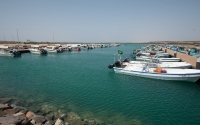
The Fishing Traditions in the Kingdom of Saudi Arabia are a set of traditions representing a cultural part of the heritage of the coastal regions in the Kingdom. On the coasts of the Arabian Gulf and the Red Sea, authentic customs and traditions related to fishing at sea have been rooted. They are associated with fishing by ships and include the mechanism of shipbuilding, the use of nets, pearl fishing, and customs of the departure of fishing boats and fishermen's return. Songs and chants ...
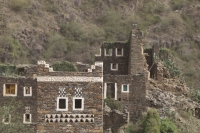
Stone Houses in Aseer are a form of construction that characterizes the urban identity of Aseer Province, southwest of the Kingdom of Saudi Arabia, and one of the traditional patterns of urban heritage in the southern provinces. They consist of forts or castles built in ancient times for fortification during maneuvers and wars. The province includes about 4,275 heritage villages, throughout which stone houses are built. Most of these architectural styles in building stone houses were formed thr...
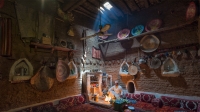
Al-Dukka and al-Kmar are two elements of the Mashab (fireplace) or coffee room, which represent a significant part of the Najdi house in Riyadh, the capital of the Kingdom of Saudi Arabia. The construction pattern of both al-Dukka and al-Kmar is common in many provinces across the north, central, and south of the Kingdom. Al-Dukka and al-Kmar can be considered secondary elements that are associated with the construction or presence of the coffee room or Mashab. 1 2 3 Al-Dukka in the Najdi house...
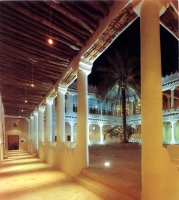
The Liwan is one of the most important elements of the Najdi home in Riyadh, the capital of the Kingdom of Saudi Arabia. It is known in another context as the Salmani style. It is one of the architectural methods to combine modernity in construction and originality. In the liwan, local yet modern construction methods are used, giving buildings a diverse and contemporary heritage style. 1 2 3 Components of the liwan The liwan consists of a set of elements, including al-Asbab (or corridor or vest...

Al-Hassir is a mat woven from palm fronds in various sizes and shapes. It was historically used in the Kingdom of Saudi Arabia to cover floors and decorate homes. Nowadays, it is considered a traditional furnishing that is part of the culture and heritage of most regions of the Kingdom. Its production was prevalent in regions where palm trees were cultivated, as al-Hassir makers required palm wicker. Al-Hassir manufacturing Al-Hassir is made from a delicate palm leaf fabric, intricately woven...